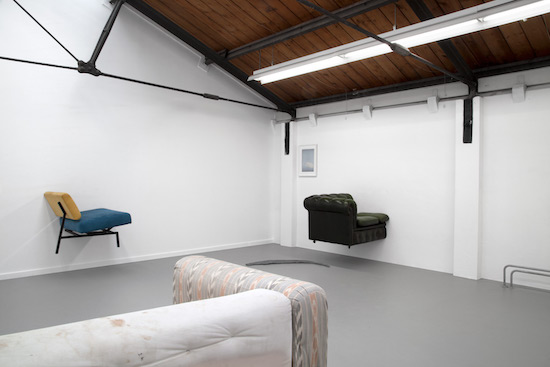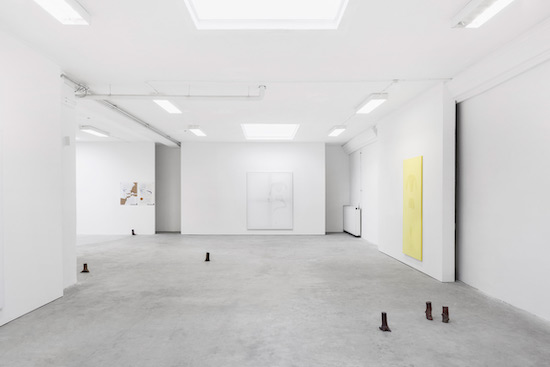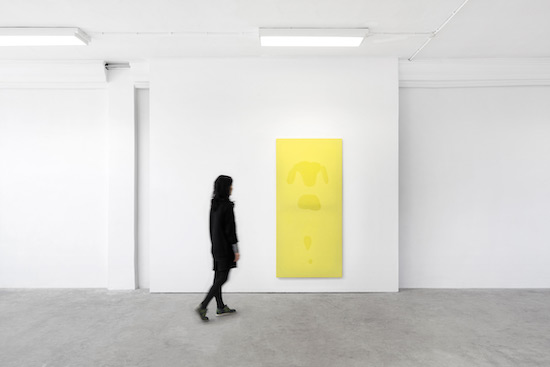Alex Farrar’s Behavioural Residue and Sweat Paintings provide opportunities to address the detritus of uncertainty, the things we shed in times of turmoil. Inspired by bitten fingernails found discarded on the studio floor, the pieces in this series take on new life as sculptural objects and invite formal discussions around colour, surface, and scale. With his Sweat Paintings, Farrar continues to develop themes around physical detritus. The individually titled works (a transparent paint on fabric) mirror sweat stains, bringing to the forefront a physical manifestation of anxiety or stress considered unclean by society, at least situationally. Unwanted sweat, a source of embarrassment, is turned into something ethereal.
Farrar, born 1986 in Leeds, is an artist based in London and Amsterdam. After completing a bachelors of Fine Art at Leeds Metropolitan university, Farrar was invited to undertake a second BA with Gerrit Rietveld Academie following which he was awarded a two year residency at the Rijksakademie in the Netherlands. Farrar is currently represented by Dürst, Britt & Mayhew.
His work has evolved over the past ten years, funnelling into developing an aesthetic language capable of addressing the precarity of the gig economy through the lens of a contemporary artist. Much of his work toes the line between an intimate introspection and the universal tremors of uncertainty that have, in many ways, come to represent the feelings of a generation.
Most recently, Farrar has focused on broadening his work to address a more practical discussion surrounding contemporary anxieties in relation to employment, communication and identity. Utilising exhibitions as process, his recent presentations have evolved through the production of works which communicate with one another through their placement in space. As a result, they have been titled following their installation, with the aim of providing the work with as much space as possible to define itself (as well as typifying the uncertainty his work often explores).
Farrar examines the communicative properties of aesthetics over extended periods of production. Allowing works to evolve over periods of years provides breathing space for the nuanced experiences illustrated in Farrar’s practice.
The overarching feeling in recent presentations has been one of departing from the personal in favour of the universal – creating works and environments in which symbols of the human experience enact an intimacy separate from the individual. The intimacy in Farrar’s practice comes from a place of accessibility, of universality, creating a sense of tension and release that remains rooted in aesthetic representation. His works re-interpret the semiotics of uncertainty, expanding myopic individual experiences into relatable visual anecdotes, providing a contemplative space in which the contemporary human condition may be examined and expanded.

Rijksakademie van Beeldende Kunsten, Amsterdam, 27 November – 29 November 2015, photos: Jack Cawood, courtesy of the artist and Dürst Britt & Mayhew, The Hague
Every show you’ve done recently, including this one, has been titled after the install. What’s the motivation for working in this way?
Honestly, it’s because I don’t know what the show is going to be or say until it’s done. I started thinking about exhibitions as artworks properly about four or five years ago, since then I produce work in groups simultaneously. When you work like that, balancing everything and being conscious of things in relation to each other, it means that I ultimately don’t see the work really until it’s put together and complete.
It’s also a way of dealing with the pressure to provide press images, titles and texts, to be a ‘good’ artist, ahead of any work actually existing. It’s a way that I can do that whilst being uncertain about what I’m making for the maximum amount of time possible.
It’s interesting that you should say that because your show Secondary Emotions –
Terrible title.
That doesn’t matter! The interesting thing was this practice of making art about being an artist. It’s something I’ve always discouraged myself from doing, avoiding getting too inside baseball with it. In your work, it’s something that I really enjoy and that I particularly enjoy in relation to the Sweat Paintings series. I’ve seen them written about as being sort of revolting or disgusting. I don’t see them that way, it’s a record of exertion. They become this fantastic metric for your practice of producing artworks and exhibitions influenced by the production of artworks and exhibitions. Even for what you’re doing now, here at Bloc, the nails and the loungewear and the pillows, it’s similar. It speaks to the cycle of creation.
That’s interesting. The sweat paintings are a good example when talking about this. I don’t give them individual titles until they’re finished. I just know that they’re part of the series. If I were telling someone that I was making the sweat paintings based on sweat and sweat forms, it would be quite disgusting. But a lot of them, particularly the Night Sweat paintings, can look incredibly light, ethereal, a lot of things other than disgusting. That’s the reality of it, what they actually do when they’re finished.
The latest Sweat Paintings (some of which are sprayed rather than brushed or poured) are now quite far from the first paintings. In some ways they are mirroring the nail biting works which were about confidence and doubt existing in the same object, which are now outwardly more confident but perhaps more inwardly (or more obviously) less so- the sweat paintings are becoming more and more faint and fragile.

‘Fall, slump, drop on a bedside cabinet in water…’ Bloc Projects, Sheffield, 13 September – 12 October 2019. Photo: Jack Cawood, courtesy of the artist and Dürst Britt & Mayhew, The Hague
I suppose that’s in the nature of everything, even something as banal as nail polish, taking something that everyone has and turning it into something that signals beauty. You know, just because you’re an artist doesn’t mean that you’re the only person in the room lacking confidence in being there and these works bring the undercurrent of your practice through materially, making it relatable to people who maybe have no experience in art practice.
I hope so. When I keep talking about four or five years ago, that’s when I was at the Rijksakademie. A lot of work came out of the first year in particular when I was feeling the pressure and also isolation of being in a studio by myself, which I’d never had before. I wanted to eschew the dialogue with context that my previous work had relied on and make groups of work that together would produce their own context. At the time I was reading a lot about consciousness, stuff about panpsychism, and I thought that I could somehow produce a sense of this, through connections between works.
At the Rijksakademie I showed the first groups in the annual open studios and people obviously associated with the context of an artist’s studio. Ever since then I’ve been trying to open the works out and let more of the world in. To let in these ideas around stress, fragility or vulnerability. I do experience these things as an artist but also as a person. The precarity and loneliness of being an artist, or self-employed, is something that exists for a lot of people in different ways.
Absolutely, it relates to corporate isolation and the anonymity of the administrative workspace, as well as the dehumanisation that people experience, in different ways, working in retail or service on a prolonged basis. We can all relate to this isolatedness of experience, or precarity. The desire to stop something, or being prevented from starting something, because of social or financial boundaries.
In this show, the work including fly tipped furniture – scares the hell out of me. The starting point for the sandbags was a sense of immobility, of not being able to move, of weight. It’s just built up from there and become more complex.
This reminds me of the series you made with the sofas cut in half and suspended from walls. A lot of them are beautiful objects but they speak to the idea of contemplative space, or study. They’re literally elevated, furthering the notion of a higher purpose to contemplation but also isolation and inaccessibility. Being cut in half, although still large enough to fit multiple people, they become seats for one. Private space isolated from or inaccessible to anyone other than the individual occupying it. More generally, its reflective of a sense of absence in your work. I just wanted to get your opinion on that?
I think it’s better the less I say about it. At that time I’d been making a lot of books, and these were some of the first things I made afterwards, initially, I think, about a space for reading. At the Rijks, there was a lot of leftover furniture around and people would just grab sofas and drag them into their studios. They were common sofas, they don’t belong to any individual.
The chesterfield is an example of this from the UK, nobody really owns them, they sit in common spaces like pubs or libraries. The height they were hung on the walls was based on how a four year old would experience the sofas, as an age when you start reading independently. There was something about the pataphysics of connecting with someone somewhere else, which I think reading does.

‘Ecstatic, darkling with…’ Dürst Britt & Mayhew, The Hague. 15 February – 31 March 2019’. All installation photos: Sonia Mangiapane. All close photos (16-DSC_6334-copy, 15-DSC_0147-copy, 18-DSC_6320-copy, 28-DSC_6276crop-copy, 28b-DSC_6282, 30-DSC_6260-copy, 30b-DSC_6263) Jack Cawood. Courtesy of the artist and Dürst Britt & Mayhew, The Hague
Something which wasn’t immediately visible for me but became apparent was how personal your work was, or maybe how much of you there is in it.
I think the work is intimate but I’m not sure about personal. I feel qualified to talk about these things: stress and anxiety. It all comes from my experience. It’s not a biography of someone else but I’m not particularly interested in my personal experience. I’ve been reading a lot of [Maurice] Merleau-Ponty over the past several months and I like what he had to say about the continuous exchange between the interior and exterior and their interconnectedness. These things are really talking about the world, a world that a lot of people share. It’s a little bit like what I’m doing with this show, trying to make it more of the world at large.
I think an artwork is something separate from the artist. It’s something between me and you. A lot of what I make is based on pre-conscious thoughts. Thoughts, feelings, ideas I can’t put in to words, so you have to find other ways.
The sweat paintings were what initially got me interested in your work. Particularly the way they come across online and on Instagram: these beautiful abstract works with soft colours and an air of vulnerability. I don’t necessarily see sweat as a negative thing. This sweat is quite a romantic sweat. Generally sweat is pretty positive for me. Although you mentioned ideas around nervousness, I see sweat as something that happens if you’re in the gym or playing sports. Maybe it’s hot out and that signifies summer or being on holiday – positive sweat, positive heat, positive exertion. The paintings provide the viewer with a lot of space, there’s room for the viewer to put themselves in the work. For me, they’re a record of having pushed one’s self. Even in the context of anxiety and nerves, it has to break eventually, like a runner’s high and the sweat mark remains as a record of that and proof of having moved beyond it. More directly, they’re an obvious success in the sense that they ended up on the walls of a gallery, an achievement many people work towards and never get to. They also exist as a record of exertion in your own practice.
I really want to understand this personal thing, why did you ask that question?
Turmoil is personal: Sweating, biting your nails or struggling through a dense text, the representation of the limp figure. It’s not a cast, it’s not a dummy, it’s not a mannequin – it’s the absence of a figure. Even in making those works, the clothes are modified and become useless, impossible to put back on and be restored to fit their purpose. Some of the works are about separation or being absent from exertion and then other works function as a record of that exertion.
I don’t know if I agree with your comments about exertion, or maybe the idea of celebrating exertion. I do think these things are intimate. They’re about things we’re ashamed of. They’re about weakness and I do enjoy somehow making them strong. The arts in general are one of the few spaces in which you can openly talk about weakness and I don’t mind doing that.
It’s funny putting them back in the context of Instagram because I do research sweat forms from Instagram – #gymsweat etc, people sharing and being proud of how hard they’re working.
It depends on whether you see exertion as being inflicted or voluntary.
I don’t know anything about going to the gym, but I think for some people it’s connected to their mental state, finding a balance between mundanity and over-stimulation. When I’m asked to write about my work, I keep coming back to the surface of the body as a liminal space, between our interior and exterior lives. Sweating can be something that happens because of conflict or dissonance between our interior life – who we think we are – and who we actually are. When we decide to do something that makes us uncomfortable in spite of wanting to do it, on a surface level we’re engaged and there by choice but internally there’s still a discomfort somewhere and sweating – or I suppose the rise in body temperature that sets it off – is a bit of an alarm system isn’t it?
What brought on the Night Sweat series and the direction your work has taken with?
It felt natural, as something even more intimate than the previous sweat paintings, it doesn’t happen in public space and it’s also not something that’s triggered by the physical world. It comes from someone who’s haunted. At the same time I made a forest of bronze stumps, and started to think of the exhibition, as something between imagination and reality, as almost being like a dream.
When the Night Sweat paintings were installed, ringing the space, making a sort of procession, they combined with semblable wood to make a paranoiac vision. With the most recent works I’ve made for this show, I’ve been inspired by some of John Martin’s paintings. With the sand-bag figures for example, I wanted them to be drained of any energy or movement. In Martin’s paintings, his figures appear powerless, dumbstruck and that’s kind of what I’m going for with these works. The Behavioural Residues refer to the remains of someone’s life, with that series I was trying to share the things that people don’t share and this is a continuation of that.
Alex Farrar’s ‘Fall, slump, drop on a bedside cabinet in water with behavioural residue (painted violet) and collapse, slide, bottom-out beside low on a bookshelf, with sag on a folding table and slip on a bedside cabinet -both- in water before behavioural residue (painted chartreuse), downswing under a broken curtain rail, and dip, crash, flat on a chest of drawers partially in water’ is at Bloc Projects, Sheffield until 12 October. Alex Farrar’s ‘Faltering, light under two screw holes, with 999 Red, shadows, screws and drilled holes, flushed, then glimmer over pieces of masking tape, with screws, drilled holes and Cherry Bomb’ is at SE8 Gallery, London, until 2 November


